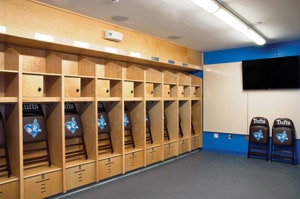
Few goods come with a set price. Vendors and manufacturers will give you a price — but how do you know that it's their best price?
In day-to-day purchases, price may be less important to you than your relationship with the sales rep, or the service you receive from the supplier. But when planning a $15 million building, each small decision becomes magnified. On a big job with a big budget, paying premiums adds up.
Administrators don't always know if they're paying a premium, because they don't necessarily have experience with either large-scale projects like facility construction or a wide range of products or brands. As a design-build firm, we at Stanmar do — and we've noticed a tremendous amount of variability in the market when it comes to how prices are set.
For example, we designed a recreation center for a university that insisted on a specific brand of door hardware. Because the hardware was particularly complicated, we asked the manufacturer's representative to write the product specification. By working directly with the representative, our client received exactly what they wanted and installation would proceed without a hitch.
 IN THE HOT SEAT Getting the best price on facility components may mean having to consider a selection of similar products.
IN THE HOT SEAT Getting the best price on facility components may mean having to consider a selection of similar products.
Soon after, we had a second client (a secondary school) that wanted the same door hardware as the university but was willing to accept "or equal" products. In this case, we wrote the specification — and as is more typical — went to multiple subcontractors to put out the spec to manufacturers' representatives. In this case, the subcontractor working with the manufacturer's rep who supplied our university job came back to us with a much higher bid than the others. When we told him so, he called up the manufacturer's rep and procured a price substantially below what the rep had quoted for the university job.
Same hardware, same supplier, but two very different prices. Why? On the first job, the rep — who knew our client was set on one brand only — had no incentive to give us a lower price. It didn't help that the client was a private institution with a significant endowment. Our second client, by making it clear it would accept "or equal" products, gave itself much more flexibility, and when the rep realized he was nowhere near the low bid, he adjusted his price accordingly to get the work. In the end, he got both jobs, and both clients were happy — but they paid different amounts.
THE PRICE IS WROUGHT
Clearly, pricing is subject to many influences. In consumer goods, certain items are intended as a means to profit rather than a source of direct profit. For example, printers are sold at a steep discount to keep you buying expensive ink cartridges. Similarly, a car salesperson's first price isn't his or her best price. Negotiation happens because a car dealer is trying to keep customers happy enough to bring the car they just purchased back to the dealer for regular maintenance and repairs, as well as to purchase future cars there.
In the sports industry, price breaks can be considerable in certain circumstances. Synthetic turf fields, for example, are sometimes provided at something close to cost — or less — because the various turf manufacturers want to market their association with a prestigious football program. Years ago, Spalding gave away its backstops to NBA teams and eventually locked up the "Official Sponsor" designation, and as a result now can charge a premium to basketball coaches who insist their teams play with the same equipment as the pros.
Nobody will give away carpeting or plumbing fixtures, but their prices can range widely. Discounts can be had from manufacturers who think a job will get them more sales down the road. Conversely, many busy manufacturers will be inclined to throw out a higher price than they would otherwise to discourage new business they probably couldn't handle anyway. Sometimes a high price will come because they don't really want the job — maybe they know the job will be a headache — and sometimes it comes down to what kind of pricing they're able to get from their suppliers on raw materials.
This leads to my first piece of purchasing advice: Learn about the marketplace. Having an understanding of the broader economy, as well as information about manufacturers and their service network, will help you better understand the possible basis for a particular price. Second, know what you want. The less you have to depend on the suppliers to inform you, the more likely you are to get a decent price the first time you ask.
I've noted already that, to get a better price, you can write your own specifications. Failing that, work with someone as cost-conscious as you are. As design-builders who guarantee a fixed price, we have to be cost-conscious. Architects, by contrast, don't always have a lot of experience on the construction side, making them more likely to have to rely on manufacturer's reps for product recommendations and spec writing. Architects also have a tendency to fall in love with a particular brand or style of light fixture, door handle, flooring or railing. If a manufacturer's rep knows that the architect is set on a particular product, the price will inevitably rise.
Anyone specifying a product ought to be flexible. Spec writers who are willing to accept an "or equal" product will do better on the bottom line. Also, it always pays for purchasers to play their cards close to the vest. To go back to the door hardware example, we try to avoid telling a manufacturer's rep who the client is. Manufacturer's reps are looking to sell product, and if a rep judges that the client has a big budget, he or she is going to throw out a very high price. If a supplier knows an architect is involved, especially an architect who has to have that one stair railing, the price will be higher. Similarly, we've noticed that suppliers have a tendency to price their products based on their history with the client. This can be helpful to a purchaser because there's cost certainty — but a lot of purchasers have no idea whether what they "normally" pay is high or low. Generally, you'll get a better price quote if your request comes out of the blue.
Getting the lowest price from the same supplier is not always easy to achieve, but this is: getting competitive bids. Sales reps have a wide latitude to set prices in their area, and if a sales rep thinks there's no competition, he will set whatever price he thinks someone will pay. If he thinks that the purchaser might go to two or three suppliers for quotes, and the product in question isn't too specialized, he's going to lower his price and be very competitive.
Here's what we do: When we're working with a client to buy a hardwood basketball floor, and we're interested in three manufacturers' floors, we call up each manufacturer and ask for the names of their best installers in the area. Each might give us one or two names — they typically won't give three or four, because they don't want all their installers competing against each other — but now we've got six bidders vying for three manufacturers' products. If both the dealers and the installers know they're competing for the business, the installers are going to tell the dealers, "I need your best price, because I want to get the job."
So, take control. Try to direct your line of inquiry so that it elicits the seller's best firm price the first time you ask. If I go with another dealer, people often say, "Well, why didn't you come back to me? I would have reduced my price." But we're in the design and construction business, not in the negotiating business. We want the best price the first time.
THE LONG VIEW
Having said all this, prospective buyers should keep in mind that the best price is not necessarily the lowest price. It is a poor strategy to drive a price down to the point at which the seller can't make a living. Your first contact with a seller sets the stage for your relationship, and a seller who is unhappy from the outset won't be there for you later.
In our business, we want to make our client happy, and part of that is making sure that subcontractors we hire will make our client happy, too. In the construction business, a subcontractor whose margins have been destroyed will nickle and dime you on every change order or take longer to complete the work.
In the interest of getting a price that is fair to the buyer, fair to the seller and fair to the client, consider a last piece of advice: be reasonable. If you can find a middle ground with sellers — even as you seek the most advantageous part of that middle ground — you'll have a better chance of getting good value for your purchasing dollar over the long haul.
Ralph J. Agostinelli, PE ([email protected]) is senior project manager at Stanmar Inc., a Wayland, Mass., design-build firm specializing in athletic and recreation facilities for private colleges, universities and secondary schools nationwide.
This article originally appeared in the June 2014 issue of Athletic Business under the headline, "Buyer'$ Guide."

Not far enough along in the planning process to be concerned with purchasing specs? Go online to check out Ralph Agostinelli’s tips for selecting the right architecture team for your project: Click Here
































